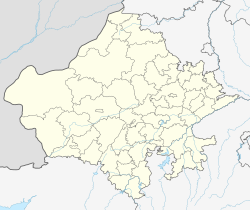History
When Gaj Singh, the Maharaja of Bikaner, was returning from Jaisalmer after his marriage with its princess, he and his entourage encamped at Chandasar. [1] His wife, who was missing her paternal home, told him that she saw Jaisalmer in Chandasar and requested him to create a pleasure garden there for her. [1] In the group she brought from her hometown, there was a gardener skilled in desert farming. [1] Gaj commissioned him to landscape a low tract called Magra. [1] He also built an artificial lake called Gaj Sagar to supply water to his wife’s garden. [1] He also built a Jal Mahal for her and established a village named Gajsinghpura after himself there. [1] Over the years, Gajsinghpura became Gajner. [1] In 1808, the troops of Jodhpur, during a siege against Bikaner, destroyed the palace. [2] The later-day palaces and canal system at Gajner were the work of Sardar Singh, Dungar Singh, and Ganga Singh. [2] When the famine of 1899 left the Gaj Sagar empty, Ganga Singh deepened the lake and widened it so that two years of water supply could be held in it. [1] Its capacity was 50 mcft (1,415,842,329.6 liters), and its catchment area was approximately 50 sq. miles (129.5 sq. km). [3]
Besides the Vallabh gardens, it was one of the two private game reserves of the Maharajas of Bikaner. [3] It was compared to being on par with British hunting estates such as Balmoral and Sandringham. [4] When important guests would visit Ganga Singh, they were taken here to shoot the great Indian bustard or the sandgrouse. [5] A record stands from the bygone days that 11,000 birds were shot in a day using as many as 40 guns. [5]
Ganga Singh commissioned Samuel Swinton Jacob, who had designed Lalgarh, to design a new palace for him. [1] [6] This palace, made of pink sandstone, was built around 1910-13. [1] It was fully equipped with comforts and included a separate wing for visitors. [6] It became known as Gajner Palace. [1] Mumbai (then Bombay)-based John Roberts and Co. was commissioned to furnish it. [1] Ganga Singh's grandson, Karni Singh, who rarely shot anything but clay pigeons and was a strict vegetarian due to the influence of his mother, who was also a vegetarian and did not herself shoot, was generally opposed to the taking of life. [1] [7] He opened a portion of the palace for his private guests and disapproved of hunting on Gajner grounds. [1] Now it is converted into a heritage hotel. [1] It is managed by HRH Group of Hotels. [8]
This page is based on this
Wikipedia article Text is available under the
CC BY-SA 4.0 license; additional terms may apply.
Images, videos and audio are available under their respective licenses.


